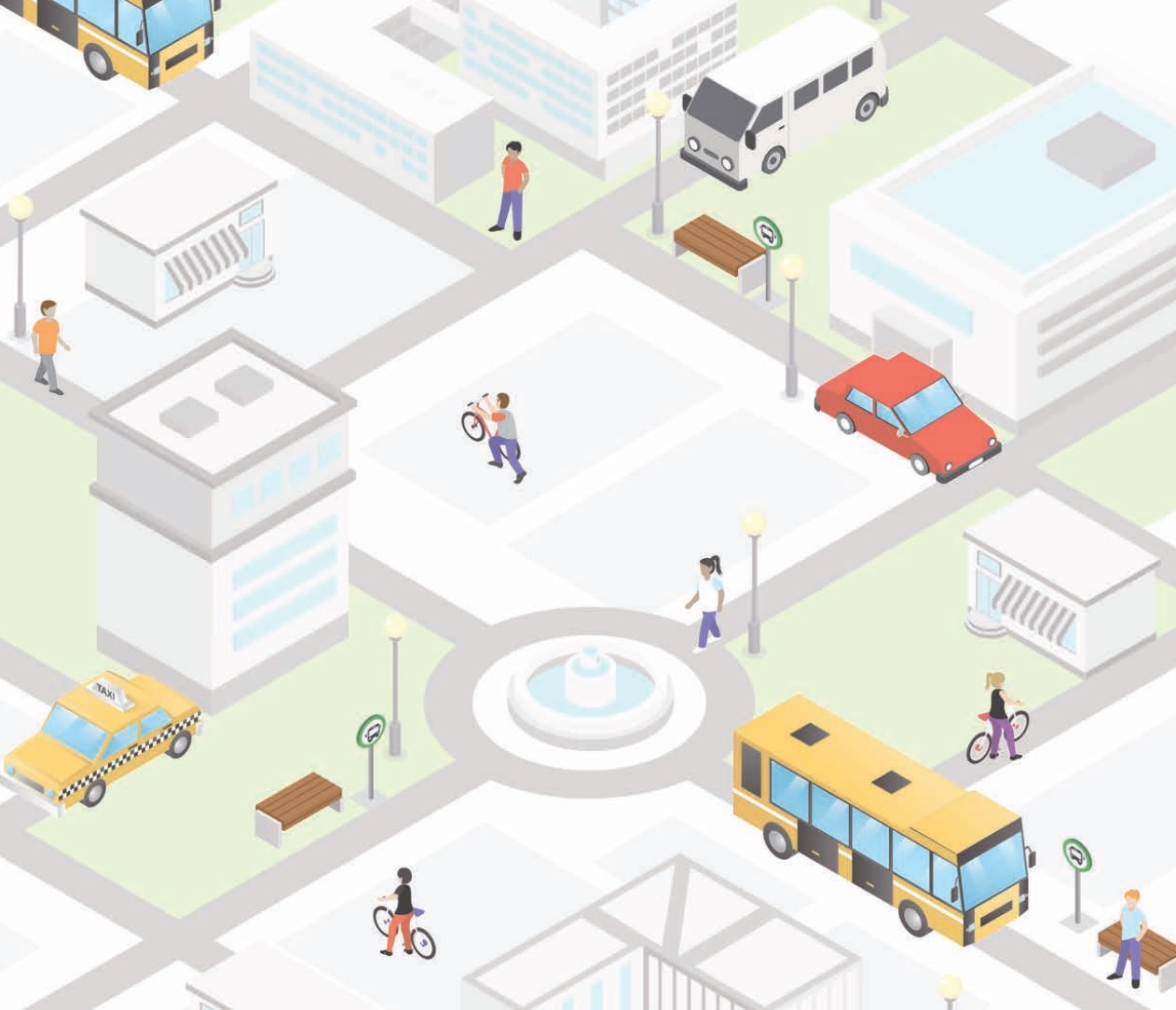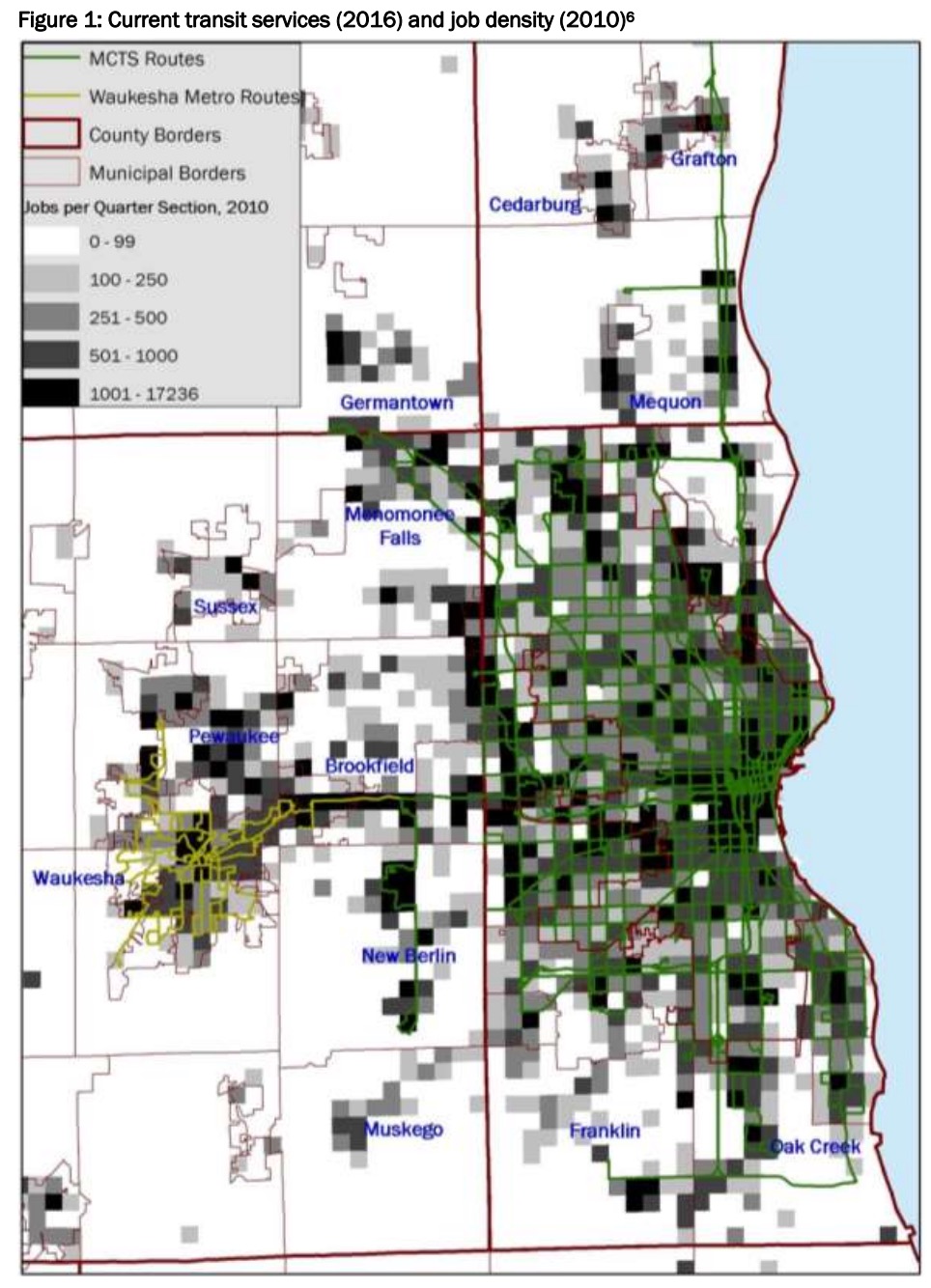PUBLIC POLICY FORUM
Introduction
 In 2013, the Public Policy Forum published Getting to Work, a report that explored efforts to connect Milwaukee County residents with major job locations in the region via public transit. The report identified several common barriers, including one known as the “last mile” problem, which can arise when transit services allow individuals to get relatively close – but not all the way – to their job sites. This challenge is particularly common in suburban areas, where jobs are more dispersed and difficult for the Milwaukee County Transit System (MCTS) and suburban transit systems to serve efficiently, but it also can arise in some parts of the city that are difficult to reach by transit.
In 2013, the Public Policy Forum published Getting to Work, a report that explored efforts to connect Milwaukee County residents with major job locations in the region via public transit. The report identified several common barriers, including one known as the “last mile” problem, which can arise when transit services allow individuals to get relatively close – but not all the way – to their job sites. This challenge is particularly common in suburban areas, where jobs are more dispersed and difficult for the Milwaukee County Transit System (MCTS) and suburban transit systems to serve efficiently, but it also can arise in some parts of the city that are difficult to reach by transit.
The last mile problem has generated considerable discussion recently among local elected officials and civic leaders who comprise the leadership of MetroGO!, a regional nonprofit organization dedicated to improving transportation connections between workers and employers in the Milwaukee metropolitan area. Those conversations led MetroGO! to commission this study.
Milwaukee is far from alone in trying to address the last mile problem. Metro areas throughout the U.S. are grappling with a range of related challenges that limit regional mobility and are experimenting with a variety of solutions. The Salt Lake City and Los Angeles metro areas, for example, have developed comprehensive studies that evaluate possible strategies for addressing both first mile and last mile problems in their regions. (First mile problems exist in areas where the nearest transit stop is not within walking distance of an individual’s home.) Even metro areas with robust transit systems, like Boston, are struggling to find solutions.
This report analyzes options for improving last mile transportation connections for the regional workforce in metro Milwaukee, with a particular focus on reducing transportation barriers for City of Milwaukee residents seeking employment opportunities throughout the region. Primary research questions include the following:
- What last mile services currently are available or have been tried in the past in the Milwaukee area and what are their strengths, limitations, and future potential?
- What additional last mile strategies are other metro areas using that could be considered for adaptation and implementation in metro Milwaukee?
- How are last mile services that may be relevant to metro Milwaukee typically designed, what are their benefits and costs, and how are they being financed?
Despite the fact that the last mile problem is ubiquitous across the country, the national research on potential solutions is relatively thin. In addition, transit systems are experimenting with a range of new partnerships with private, technology-based services (e.g. Bridj, Lyft, and Uber), but those partnerships are new and there is no comprehensive understanding yet regarding their costs and benefits. Consequently, we rely heavily on case studies in this report for insights regarding the potential pros and cons of the strategies considered. Conversations with transit system officials in other cities complemented our research.
A key conclusion from our analysis is that there is no silver bullet to solve last mile challenges. Rather, different solutions may be effective in different contexts. Often, a combination of multiple solutions is the best strategy for improving transportation access in a given area.
In addition, transit systems cannot be expected to solve all of metro Milwaukee’s distinct last mile challenges on their own. Previous land use decisions have made it difficult – and in some cases impossible – for transit systems to effectively serve many employer locations, particularly given budget realities. Furthermore, the desire to improve transportation access to employers is just one of many worthy objectives that must be considered in designing an optimal regional transit system; demand for non-employment travel also must be considered, along with issues of cost, travel time, and other factors.
Nevertheless, it is our hope that the strategies explored in this report will provide viable possibilities for regional transit system leaders, policymakers, and businesses to consider as they seek to improve workforce mobility in the Milwaukee metropolitan area.
Background
While most of the locations in the Milwaukee metropolitan area with strong job concentrations are served by public transit to some degree, some are completely disconnected from the transit system. Figure 1 overlays a regional job density map with current transit services offered by the Milwaukee County Transit System (MCTS) and Waukesha Metro Transit. Each square on the map covers a ½ mile by ½ mile area and is shaded based on the concentration of jobs located within it. Black squares are the most job rich, containing at least 1,000 jobs each.
Figure 1 shows the extent to which transit services are fairly robust within the City of Milwaukee, but are less available in the surrounding suburbs. The local bus services provided by MCTS and Waukesha Metro Transit currently meet only in one location: Brookfield Square. MCTS does provide limited services into Waukesha, Ozaukee, and Washington counties through cost-sharing agreements with those counties. Waukesha County also provides bidirectional service on several commuter bus routes (not shown on the map) that Milwaukee residents can access in downtown Milwaukee and at the intersection of 35th St. and Wisconsin Ave.
Since 1/4 mile is typically considered a walkable distance, the squares on the map that are not traversed by at least one transit line are the least accessible. Job hubs in Cedarburg, Mequon, Germantown, Pewaukee, and Muskego all fall into this category.
It is critical to note that many additional places that are served by at least one transit line only are accessible by transit at limited times of the day and week, which can make them ineffective transportation options for workers. For example, the City of Franklin contains an area with a strong concentration of jobs (the Franklin Industrial Park), which appears to be accessible by transit on the map. The bus route that serves that area, however, only operates on Saturday mornings to bring people to and from the Milwaukee County House of Correction, which is located nearby.
Poor transit access to jobs in the Milwaukee area is a problem that grew significantly between 2001 and 2014. A recent study by the UWM Center for Economic Development found that cuts made to the transit system because of budget challenges resulted in a minimum of 20,018 fewer jobs being within 1/4 mile of a public transit route in 2014 than would have been accessible via the transit system that was in place in 2001. 5 MCTS has been able to avoid further service cuts for the past several years, but the system remains significantly less robust than it was in the past.
Download full version (PDF): The Last Mile
About the Public Policy Forum
www.publicpolicyforum.org
Established in 1913 as a good government watchdog, the Public Policy Forum is a private, non-profit, independent research organization dedicated to enhancing the quality of public policy decision-making in southeast Wisconsin. Our research and facilitation activities encourage elected officials and community leaders to find effective, data-driven solutions to pressing policy challenges, and promote productive, nonpartisan discussion among the public and private sectors.
Tags: MCTS, Milwaukee, Milwaukee County Transit System, Public Policy Forum, WI, Wisconsin







 RSS Feed
RSS Feed
I don’t see any mention of using autonomous buses to deal with both first and last mile services. There have been many demos in the EU with these vehicles and there are some now underway in the US (Jacksonville, Fla and Concord CA). Companies involved include Easy Mile (French) and Best Mile (Swiss) http://www.easymile.com and http://www.bestmile.com